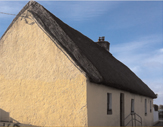 |
|
The Ballycotton Bay area has a character all of its own. Rich plains, clean and unspoiled sandy beaches, historic towns and heritage centres, rocky bays and dramatic coastal cliff walks and scenery, forested landscapes and walks, less crowds, more peace and quiet. There are small towns and villages, castles, ruined monasteries, a living cathedral and a beautifully preserved round tower at Cloyne, a unique coastal bird sanctuary and at Fota a unique Wildlife Park. This is ideal cycling country, and motoring country too. In the area there are still undiscovered places and secret sandy bays for you to discover and explore. |
|
|
|
|
Ballycotton village, a 30 minutes drive East of Cork city is a hilly fishing port much
favoured by deep sea anglers. It offers fantastic views over a boat filled harbour to a steep island crowned by a lighthouse. There are cliff walks, and inland an extensive marshy bird sanctuary.
The picturesque angling village of Ballycotton is much favoured by deep sea anglers. It has a long maritime history, and it was off Ballycotton in 1837 that the
famous steam ship the “Sirius” was lost. She had previously been the first passenger steam ship to cross the Atlantic. Today the Royal National Lifeboat stationed at Ballycotton is one of the most modern afloat. Just off the coast,
Ballycotton Island has a 19th century lighthouse.This service has a very
commendable history with many famous rescues in years gone by.
Ballycotton Lifeboat Station
Ballycotton lifeboat station opened in 1858. One of the most famous lifeboat rescues was carried out by the Ballycotton lifeboat when the RNLI's Gold medal for gallantry was awarded to coxswain Patsy Sliney, Silver medal to the second coxswain, J L Walsh and motor mechanic T Sliney, and Bronze medals to M C Walsh, J S Sliney and W Sliney and T Walsh for the service on 11 February 1936 when the Daunt Rock Lightvessel broke away from her moorings. A whole gale was blowing, with a very heavy sea, rain and snow. When the lifeboat put out she met seas so mountainous that spray was flying over the lantern of the lighthouse 196ft high. The lifeboat did not return to her station for three days. She had then been out on service for 63 hours, during which time her crew had only three hours' sleep. For 25 hours they had no food and all came back suffering from colds and salt water burns. The lightvessel's crew of eight were rescued. This was one of the most exhausting and gallant services in the history of the Institution.
Ballycotton Lighthouse
Sited on Ballycotton Island, the light was first exhibited on June 1, 1851. The tower was painted black in 1902. In 1975, the light was converted to electricity and the original 1851 optic was replaced by an AGA sealed-beam lamp array. The lighthouse was automated in 1992. |
|
|